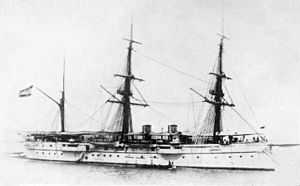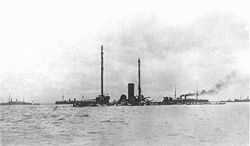Spanish cruiser Castilla
 An unidentified Aragon-class (here called Castila-class) cruiser in the 1880s or 1890s, showing the appearance of Castilla | |
| Career | |
|---|---|
| Name: | Castilla |
| Namesake: | Castile, an historical region of Spain |
| Ordered: | 1869 |
| Builder: | La Carraca shipyard, Cadiz, Spain |
| Laid down: | May 1869 |
| Launched: | August 1881[1] |
| Completed: | 1881 or 1882[2] |
| Commissioned: | 1882 |
| Fate: | Sunk 1 May 1898 |
| General characteristics | |
| Class & type: | Aragon-class |
| Type: | unprotected cruiser |
| Displacement: | 3,289 tons |
| Length: | 236 ft 0 in (71.93 m) |
| Beam: | 44 ft 0 in (13.41 m) |
| Draft: | 23 ft 6 in (7.16 m) maximum |
| Installed power: | 1,400 ihp |
| Propulsion: | 1-shaft, 3-cylinder, horizontal compound |
| Sail plan: | barque-rigged |
| Speed: | 14 knots |
| Complement: | 392 officers and enlisted |
| Armament: |
As completed, included 8 x 8 inch (203 mm) 180 pounder rifled muzzle-loading guns By 1885: 4 x 5.9 inch (150 mm guns 2 × 4.7 inch (120 mm) breech-loading guns 2 x 87nbsp:mm guns 4 x 75 mm guns 10 x machine guns 2 × 14 inch (356 mm) torpedo tubes |
| Armor: | none |
| Notes: | 460 tons of coal (normal) |
Castilla was an Aragon-class unprotected cruiser of the Spanish Navy that fought in the Battle of Manila Bay during the Spanish-American War.
Technical characteristics
Castilla was built at Cadiz, Spain. Her construction as an armored corvette with a central battery ironclad design began in 1869, with plans to give her 890 tons of armor and 500 mm (19.7 inches) of armor at the waterline. In 1870, her design was changed to that of an unprotected cruiser or wooden corvette, and, after political events delayed her construction,[3] she finally was launched in this form in 1881[4] and completed in 1882.[5] Her original conception as an armored ship and the change to an unarmored one during construction left her with an overly heavy wooden hull that was obsolescent by the time of her launch.[6]
She had two funnels and was rigged as a barque.[6] Her machinery was manufactured at the naval shipyard at Ferrol.[5] The original main battery of Armstrong-built 8-inch (203-mm) guns was obsolescent when she was completed, and were quickly replaced with more modern Krupp-built guns, with the 5.9-inch guns mounted in sponsons.[6] Designed for colonial service, she was never intended to fight the kind of heavily armed, armored, steel-hulled warships she would face in the Battle of Manila Bay.[5]
Operational history
Castilla was commissioned in 1882. She spent her early years in Spanish waters as a part of the Spanish Navy's Instructional Squadron, making several courtesy visits to Mediterranean ports.[5]
In 1890, Castilla was sent to the Philippines to reinforce the Asiatic Squadron. During the first two years of the Philippine Revolution in 1896–1897, referred to by colonial Spaniards as the "Tagalog Revolt", Castilla patrolled to intercept contraband destined for the Philippine insurgents and supported Spanish Army forces fighting ashore in Cavite Province on Luzon.[5]
When the Spanish-American War broke out in April 1898, Castilla was part of the squadron of Rear Admiral Patricio Montojo y Pasarón in Manila Bay. At 1100 hours on 25 April 1898, Castilla and five other ships of the squadron set out for Subic Bay, where Montojo hoped to take advantage of minefields and shore batteries in the likely event of an attack by U.S. Navy forces on his squadron. During the voyage, Castilla began to take on water through her propeller shaft housing. Her machinery and boilers had been in such poor shape that she was capable only of low speed already, and the only method of stopping the flooding—plugging the hole with concrete—immobilized her propeller shaft, leaving her to rely on sails or towing for propulsion. Montojo's flagship, unprotected cruiser Reina Cristina, took her under tow.[7]



Hit by five 8-inch (203-mm) and 6-inch (152-mm), twelve 5-inch (127-mm), and about 33 smaller shells, Castilla soon sank, a total loss, having suffered 23 to 25 men killed and 80 wounded during the battle.[5]
Trophy cannon
In 1902, one of the breech-loading guns from Castilla was presented by Oscar F. Williams, U.S. Consul at Manila, to the City of Rochester. New York. It is currently located in Highland Park in Rochester. The Vermont State House features a pair of the same cannon, with an almost identical plaque, as decoration on the front lawn. The only difference in the plaque is the parts pertaining to the locality the gun was presented to.
Notes
- ↑ The Spanish-American War Centennial Website: Castilla claims an 1879 launch, but Conway's All the World's Fighting Ships 1860–1905, p.383, claims 1881 and The Spanish-American War Centennial Website: Spanish Wooden Cruisers specifies August 1881
- ↑ The Spanish-American War Centennial Website: Castilla claims completion in 1881, while The Spanish-American War Centennial Website: Spanish Wooden Cruisers claims completion in 1882.
- ↑ The Spanish-American War Centennial Website: Castilla and The Spanish-American War Centennial Website: Spanish Wooden Cruisers
- ↑ The Spanish-American War Centennial Website: Castilla claims the launch year was 1879, but The Spanish-American War Centennial Website: Spanish Wooden Cruisers and Conway's All the World's Fighting Ship 1860–1905, p. 383, set the year as 1881
- ↑ 5.0 5.1 5.2 5.3 5.4 5.5 5.6 The Spanish-American War Centennial Website: Castilla
- ↑ 6.0 6.1 6.2 Conway's All the World's Fighting Ships 1860–1905, p. 383
- ↑ Nofi, p. 69-70; The Spanish-American War Centennial Website: Castilla
- ↑ Nofi, p. 17, 70
- ↑ 9.0 9.1 The Spanish-American War Centennial Website: Don Juan de Austria
- ↑ Nofi, p. 20
- ↑ Nofi, p. 20-23
- ↑ For details of Castilla's experience in the Battle of Manila Bay, see The Spanish-American War Centennial Website: Castilla
See also
- Battle of Manila Bay
- Patricio Montojo y Pasaron
References
- Chesneau, Roger, and Eugene M. Kolesnik, Eds. Conway's All The World's Fighting Ships 1860–1905. New York, New York: Mayflower Books Inc., 1979. ISBN 0-8317-0302-4.
- Nofi, Albert A. The Spanish-American War, 1898. Conshohocken, Pennsylvania:Combined Books, Inc., 1996. ISBN 0-938289-57-8.
External links
- The Spanish-American War Centennial Website: Castilla
- The Spanish-American War Centennial Website: Don Juan de Austria
- The Spanish-American War Centennial Website: Spanish Wooden Cruisers
- Department of the Navy: Naval Historical Center: Online Library of Selected Images: Spanish Navy Ships: Castilla (Cruiser, 1881–1898)

